Speech Notes for a Talk to CEDA/Promina Economic and Political Overview

Malcolm Edey
Assistant Governor (Economic)
Notes for a Talk to CEDA/Promina Economic and Political Overview
Sydney –
Good morning and thank you to CEDA for the invitation to speak today.
The last two weeks has been a period when there's been a good deal of Reserve Bank commentary made available to the public – first in our quarterly Statement on Monetary Policy, and then in the Governor's parliamentary testimony last week. That material is still very fresh and it's not my intention to add anything new to it today. What I plan to do instead is to make some observations that draw on the statements already made. In doing that, I'll start with a brief overview of the international scene, and then move on to the situation in Australia.
My first observation is that the international environment in which Australia finds itself at the moment is quite a favourable one (Graph 1). Growth of the world economy last year was 4.9 per cent, which is around the strongest figure for the last 30 years. Most expectations at this stage are that 2005 will be another strong year. For example, the latest Consensus forecasts, taken as at February, imply global growth this year of 4¼ per cent. If that forecast is realised, it would be the third successive year of above average growth, albeit a bit slower than last year's result.
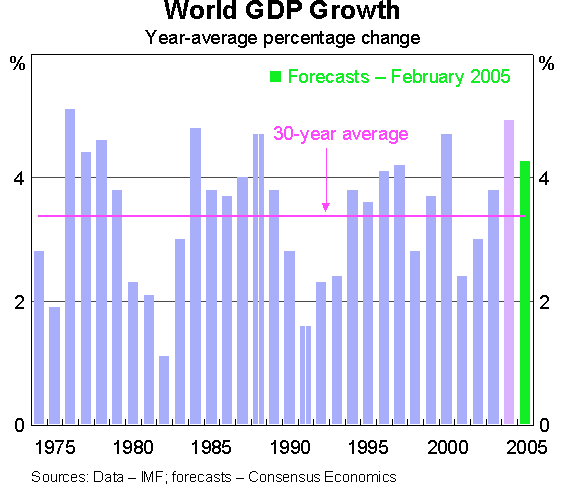
I won't have time to go into the global situation country by country, but it's worth taking a separate look at the US business cycle, which is still such a big influence on the world economy as a whole (Graph 2). The US is now in its fourth year of expansion after the recession at the start of the decade. The recovery initially got off to a fairly slow start. But the early concerns about lack of recovery in the business sector, and in employment, have now faded. Last year the US economy grew by just under 4 per cent, with the latest indicators generally pointing to further momentum coming into the early part of this year. So overall, the US recovery is looking well entrenched.
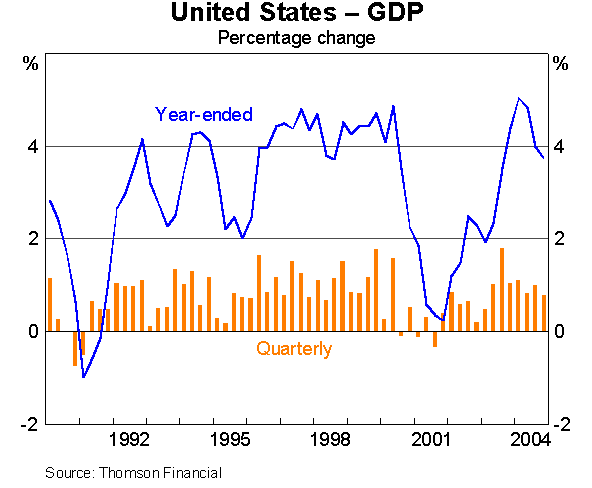
The other important driver of global growth at the moment is China (Graph 3). In the last couple of years the Chinese economy has been growing at rates not much below 10 per cent, and directly accounting for about a quarter of the overall growth in the world economy and in global trade. The main concern of the Chinese authorities last year was that the economy was overheating, and they have taken various measures since late 2003 to try to rein this in through credit controls and the like. These now seem to be having some effect, although any slowing to date seems quite mild.
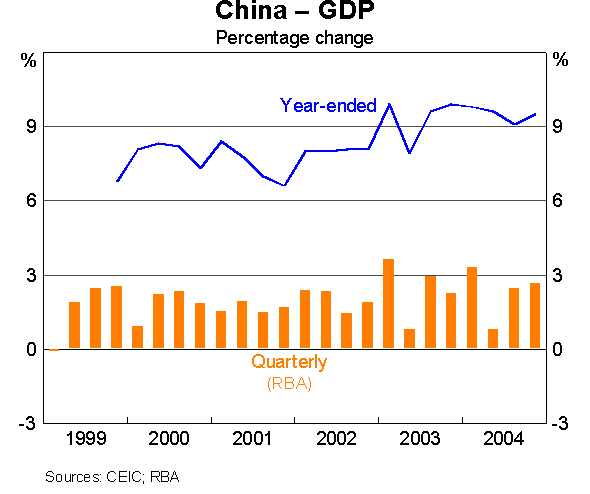
The recent performance and outlook in other parts of the world is more mixed (Table 1).
- Recent GDP outcomes for the euro area and Japan have been disappointing;
- But growth in most of the smaller east Asian economies remains quite strong, even if it has slowed a bit since last year.
| 2004 | 2005 Consensus Forecast | |
|---|---|---|
| United States | 4.4 | 3.5 |
| Euro Area | 2.0 | 1.7 |
| Japan | 2.6 | 1.1 |
| China | 9.5 | 8.4 |
| Other east Asia | 5.8 | 4.4 |
| World | 4.9 | 4.3 |
Obviously all these forecasts are going to be subject to revision as the year progresses. But overall, as I indicated at the outset, growth of the global economy at this stage is looking quite strong. One important consequence of this has been upward pressure on commodity prices. Internationally, the most widely publicised aspect of that was the run-up in oil prices, which peaked in October last year. More directly relevant to Australia has been the sharp rise in a range of other resource prices. World prices of Australia's base metals exports are now up by more than 40 per cent over the past two years. For iron ore and coal, substantial increases in contract prices are set to take effect this year, after the sharp rises already negotiated in 2004.
A useful summary statistic for these effects is the movement in Australia's terms of trade (the ratio of export to import prices, Graph 4). Essentially this summarises the purchasing power generated by a given volume of exports. This ratio has already increased by 11 per cent over the past year. Some rough figuring suggests that the price increases for coal and iron ore over coming months will boost our overall index of commodity prices by over 20 per cent, and our terms of trade by a further 10 per cent. This represents a significant stimulus to national income and spending.
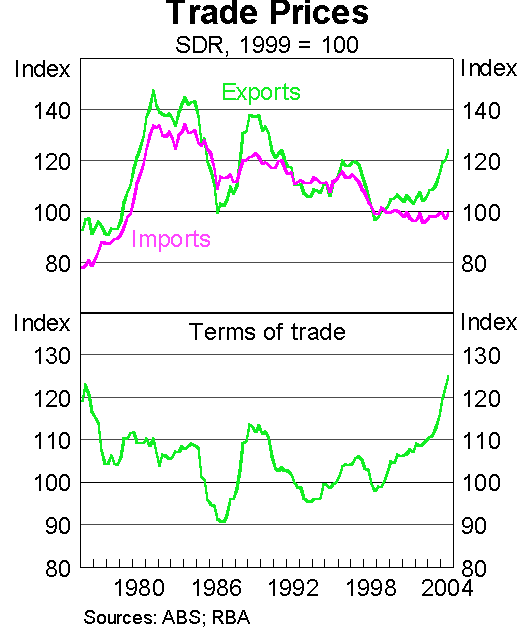
So the international background is one of above-average economic growth, and rising prices of the products that Australia exports.
Given this background, how has Australia been performing? The last national accounts showed that output growth slowed during 2004 from the fast pace of the previous year (Graph 5). Growth was 3 per cent in the year to the September quarter, and the numbers out next week for the December quarter are likely to show annual growth to have slowed further. Domestic demand has also slowed down, but is still growing quite a bit faster than output.
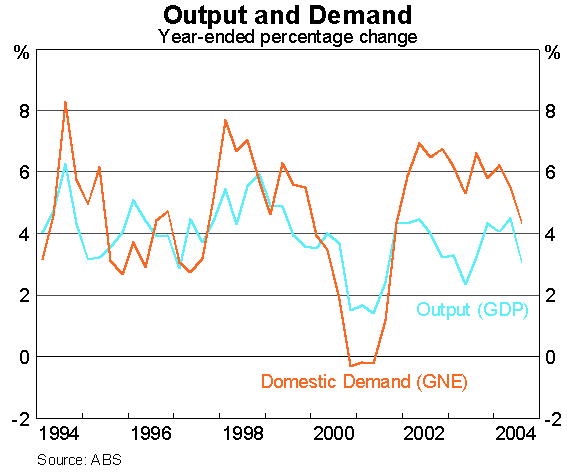
In its recent statements, the Bank has made two observations about this recent performance. The first is that the slowing in growth seems at odds with general perceptions that the economy is growing strongly. Measures of business and consumer sentiment, for example, are at levels that would normally be associated with well-above-average growth. In the NAB survey of the non-farm business sector, businesses reported that conditions at the end of last year were close to their best since the survey began in 1989 (Graph 6). They did show a drop in January, but that seems to have been mainly seasonal. Other indicators, like the growth of business borrowing, profits and the rising share market, also bear out that the business sector in aggregate is enjoying strong conditions.
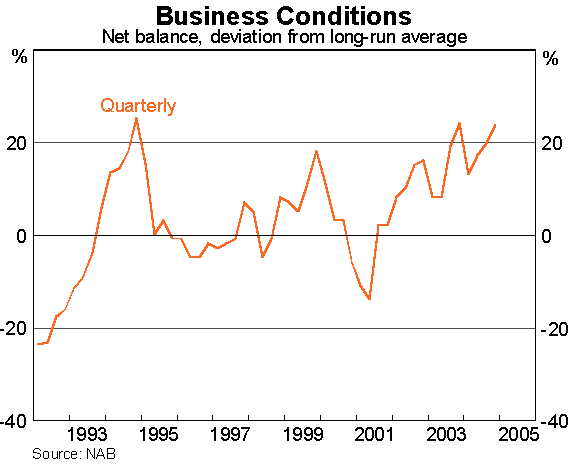
For the household sector, the Westpac-Melbourne Institute survey similarly reports sentiment at close to record levels (Graph 7). In fact this strengthened towards the end of last year and into the early part of 2005.
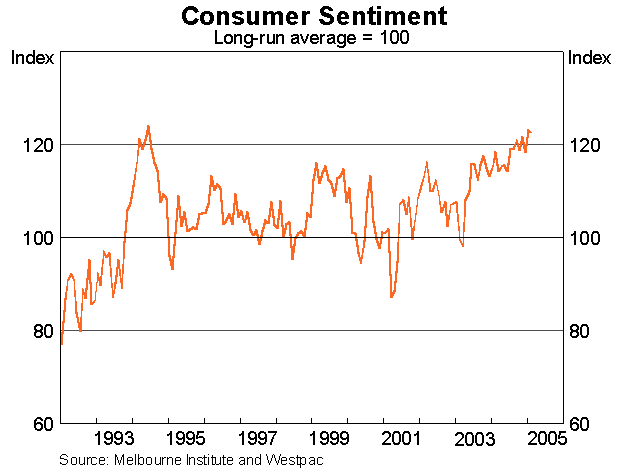
Another area of notably strong economic data has been the labour market (Graph 8). In the year to January, employment grew by 3.2 per cent, which is well above the trend growth in the labour force. Unemployment fell to 5.1 per cent, its lowest level since the 1970s. Other indicators such as job vacancies and hiring intentions are also pointing to strong labour demand.
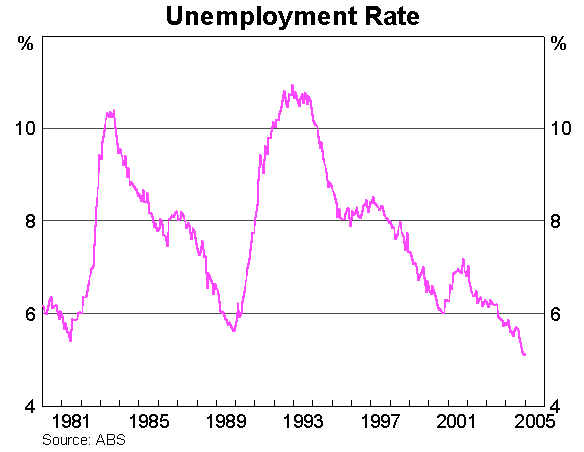
Obviously, it will never be the case that all economic data point in the same direction at a given time. One weaker indicator attracting comment recently has been retail sales, though it seems likely that this overstates any weakness in overall consumption spending. But overall, the sense we get from the general run of economic data is that confidence is high, and that demand conditions are providing plenty of encouragement to growth.
The second main observation that the Bank has made in its recent statements concerns the balance of supply and demand in the economy. Taking the GDP figures at face value, what they indicate is that growth of output slowed down even though domestic demand over recent years has been running at a pace well above its longer-run trend. So during that period we have had a combination of strong domestic demand and better-than-average growth in the world economy, as well as a boost to national income from rising commodity prices. This combination of circumstances makes it hard to argue that the overall demand conditions facing the Australian economy have been deficient. Rather, what the Bank has argued is that it's becoming more likely growth is being constrained on the supply side.
The clearest indication of emerging pressures on supply capacity has been in the disappointing performance of exports over the past year or two (Graph 9). Despite the more favourable international situation, total exports as at the September quarter were not much changed from their level of four years ago. The weakness was spread across all the main categories of exports. However, some of the weakest results were in resource exports, which in late 2004 were actually below the level reached in 2000. This is a series that in the 1990s grew at an average rate of more than 6 per cent.
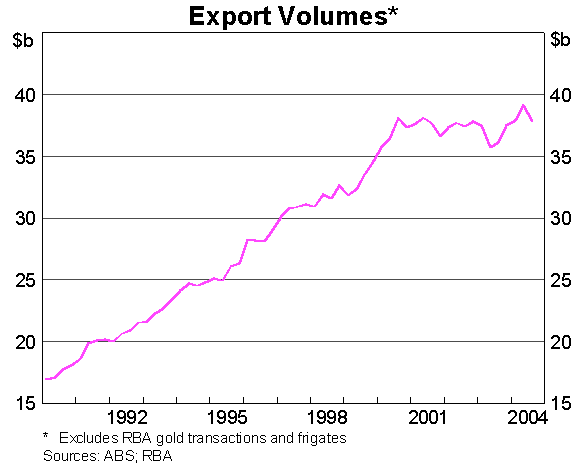
The performance of resource exports is something that has gained a lot of attention recently, and we devoted a special chapter to it in our recent quarterly statement. Our assessment was that the reason for the lack of volume growth to date is a combination of constraints, in extraction capacity and in transport infrastructure. The situation is quite a complex one, but the good news is that there are some significant capacity expansions now underway. So the prospects are that resource exports should start to pick up soon, even though some of the capacity issues might still take a while to be resolved.
At a more general level, the proposition that supply considerations are becoming more important should not strike people as all that surprising. The economy is now in its 14th year of expansion, and during that time substantial surplus capacity has been absorbed. The NAB survey, for example, reported that businesses' capacity utilisation at the end of last year was as high as at any time over the 15 years of the survey (although again, there was a fall in January which appears to have been mainly seasonal). It's also clear the economy has been eating into surplus labour capacity, with unemployment down from a peak of almost 11 per cent to just over 5 per cent now. Reports of labour shortages are becoming widespread. This point is picked up in some of the business surveys which report the difficulty of finding suitable labour now is as high as it's been in the last two decades (Graph 10). The surveys also provide evidence that, for many businesses, shortages of labour have become a bigger constraint than traditional concerns about demand and sales.
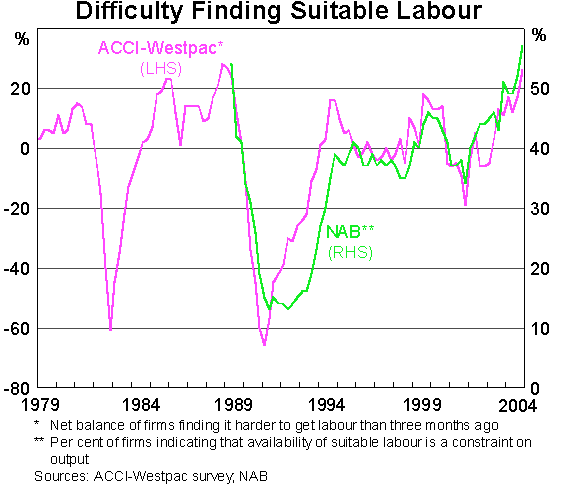
Before I sum up, I should reiterate that my comments today are not meant to convey anything different from the statements already made by the Bank in the last couple of weeks.
To summarise the main points. The world economic situation to date has been a favourable one for Australia. Current expectations for the world economy are for a third year of above-average growth. In Australia, the evidence is that there has been no shortage of demand over recent years, and that businesses are becoming more concerned about constraints on supply capacity. With a favourable world environment, rising commodity prices, and high levels of confidence domestically, the prospects are that demand conditions will continue to encourage growth in the period ahead.
Thank you very much, and I wish you every success in the coming year.